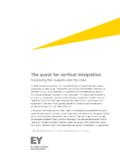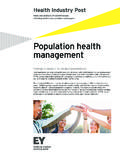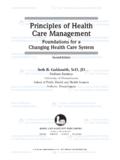Transcription of Employee Benefit Trends in India – challenges and ...
1 Benefits & Compensation International DECEMBER 2009 3 Employee Benefit Trends in India challenges and opportunitiesNaveen Kumar MidhaNaveen Midhais the Employee Benefits Practice Leader for Willis India . His career has included senior positions with various insurance entities in and outside India . During his eight years in the Indian insurance industry, Mr Midha has gained experience in areas of benefits design consulting and product design and has strategic and operational expertise in health -care management and other critical areas of Employee benefits. In his current role at Willis, he is responsible for the development and implementation of Employee Benefit activities design, placement, negotiation and servicing on behalf of companies.
2 Mr Midha has aBachelor of Business Studies degree from the University of Delhi and is a qualified Cost and Works Accountant (ICWA), India . He also has an MSdegree in Risk Management from The School of Risk Management, Insurance and Actuarial Science, St. John s University, New York, and a Master s degree in Finance from Delhi a much-watched, analysed and observed country is standing expectantly on the brink of economicsupremacy and leadership. Before it can realize its vast,latent economic potential, however, it has to improve its rapidly expanding but equally challenge-ridden health -care system.
3 While the impediments in this areaare complex and unique, the opportunities are alsomyriad and exciting. On the one hand, we have the multi-faceted demands and expectations of the mushroomingmiddle class coupled with an ageing population, a largershare of the global disease burden and a severely tested,not-so-strong health -care delivery mechanism. On theother hand, India has the fantastic opportunity to learnfrom (and, in fact, pre-empt) the challenges that health -care systems of other developed countries are dealingwith primarily by incentivizing private-sectorparticipation in financing and delivery, improving accessand quality and propelling the health insurance all these anticipated metamorphoses, we haveCorporate India with its own set of aspirations andresponsibilities to cater to employees concerns.
4 As withtheir peers in any other economy, Indian employers arefaced with an increasingly competitive search for skilledemployees, with their diverse expectations anddemographic profile, which has brought about dramaticchanges to human resource management. The growingcomplexities in products, ever-changing governmentlegislation and expanding administrative burdens arealso posing new questions. Added to these challenges isthe spiralling benefits cost resulting in the excessivefinancial burden of health care for employers. In short,organizations in India are being challenged in all aspectsof Benefit programmes.
5 No wonder all this decision-making is proving not to be an easy job for an article explores the Employee benefits market inIndia and the emerging Trends . It details the existinghealth-care market and how it has evolved since the1950s, elaborating on the present drivers of , it describes the Trends associated with the market(read Corporate India ) and how they are expected toevolve and have an impact over the next few EXISTING health -CARE MARKET An analysis of the prevailing demographic profile ofIndia will provide us with a common-sense check of theexisting potential, changing shape and future growth ofthe health -care market in India .
6 The Population and its health -Care PotentialThe current primary driver of growth in the health -caresector is India s enormous population. Estimated at billion, it is currently the second largest in theworld. It is growing at a rate of annually and isexpected to overtake that of China by 2030. By 2050,the population is projected to reach , this population includes a middle-incomegroup of around 385 million people1. However, only 15 million are covered by private health insurance,indicating the massive potential for growth.
7 In terms of revenues, in 2008 health insurancepremiums amounted to approximately US$450 million*as against the estimated potential of US$8 billion. If welook at the overall health -care market , it is growing ata brisk 16%, with an estimated market potential ofUS$30 billion. However, even at present levels, themarket works out as US$30 per capita and is theequivalent of only 6% of India s gross domestic product(GDP). This further indicates the enormous potential ofthe market. Public Private Partnership in health CareIndia spends around just of its GDPon health -carefunding and less than a quarter of that sum on the actual delivery of health -care programmes.
8 It is therefore of little surprise that in urban health carenearly 80% of funding comes from the private sector * 1 = US$ ; 1 = US$ as at 13 November 2009 The health -care market includes retail pharmaceutical, health -care services, and medical and diagnosticequipment and & Compensation International DECEMBER 2009 and only 20% from the public sector. While the role of central government is limited to family welfare and disease control programmes, the state governmentsare responsible for primary and secondary medical care, with a limited role in specialty care.
9 Conversely,private health -care providers consist of privatepractitioners, for-profit hospitals and nursing homes, andcharitable hospitals. Unless there is a decline in thecombined federal and state government deficit, currentlystanding at around 8%, the possibility for significantlyenhanced public health spending will be addition, as much as 84% of health -care expenses are funded out of pocket by individuals and around 16% come from private insurance, which ispredominantly employer funded (see FIGURE1 below) facts and concerns have been acknowledged inthe National health Policy.
10 It is indeed unfortunate that,even today, people in India have to borrow money orsell assets to fund in-patient care and, as a result, oftendefer or even deny themselves treatment. As aresult, the expectation of an Indian Employee thathis/her employer will provide adequate health -carecoverage is both understandable and of India s Benefits SystemThe evolution of India s benefits system can be dividedinto three distinct phases, as follows:Phase I (1950s-1970s). This was when policy was basedon two principles, namely that employer employeeparticipation for long-term funding is important andthat it is the State s responsibility to provide health careand other benefits for the people (especiallygovernment employees and the rural population).







